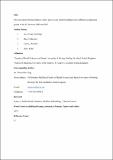Files in this item
Association between tobacco control policies and current smoking across different occupational groups in the EU between 2009 and 2017
Item metadata
| dc.contributor.author | So, Vivian H. T. | |
| dc.contributor.author | Best, Catherine | |
| dc.contributor.author | Currie, Dorothy | |
| dc.contributor.author | Haw, Sally | |
| dc.date.accessioned | 2019-07-09T14:30:12Z | |
| dc.date.available | 2019-07-09T14:30:12Z | |
| dc.date.issued | 2019-08 | |
| dc.identifier | 259034842 | |
| dc.identifier | 59c09b5a-2cd5-4d69-9d3c-556758157ff0 | |
| dc.identifier | 31213489 | |
| dc.identifier | 85067413619 | |
| dc.identifier | 000478920900012 | |
| dc.identifier | 31213489 | |
| dc.identifier.citation | So , V H T , Best , C , Currie , D & Haw , S 2019 , ' Association between tobacco control policies and current smoking across different occupational groups in the EU between 2009 and 2017 ' , Journal of Epidemiology and Community Health , vol. 73 , no. 8 , pp. 759-767 . https://doi.org/10.1136/jech-2018-211935 | en |
| dc.identifier.issn | 1470-2738 | |
| dc.identifier.other | ORCID: /0000-0001-7321-9394/work/60196053 | |
| dc.identifier.other | ORCID: /0000-0001-5839-862X/work/79565109 | |
| dc.identifier.uri | https://hdl.handle.net/10023/18060 | |
| dc.description.abstract | BACKGROUND: This study investigated the cross-national and longitudinal associations between national tobacco control policies and current smoking in 28 European Union (EU) member states between 2009 and 2017. It also examined the interaction between tobacco control policies and occupational status. METHODS: We used data from four waves of Eurobarometer (2009, 2012, 2014 and 2017). The total sample size was 105 231 individuals aged ≥15 years. Tobacco Control Scale (TCS) scores (range 0 to 100) for years 2005, 2007, 2012 and 2014 measured the strength of country-level tobacco control policies. Logistic multilevel regression analyses with three levels (the individual, the country-year and the country) were performed with current smoker as the dependent variable. RESULTS: Across the EU, average smoking prevalence fell from 29.4% (95% CI 28.5% to 30.2%) in 2009 to 26.3% (95% CI 25.4% to 27.1%) in 2017. We confirmed that cross-nationally, strong national tobacco control policies are significantly associated with a low probability of smoking. A one-point increase in TCS score was associated with lower odds of smoking (OR=0.990; 95% CI 0.983 to 0.998), but longitudinally (within-country) increases in TCS were not associated with current smoking (OR=0.999; 95% CI 0.994 to 1.005). Compared with those in manual occupations, the cross-national association was stronger in the upper occupational group (conditional OR for the interaction=0.985; 95% CI 0.978 to 0.992) and weaker in the economically inactive group (conditional OR for the interaction=1.009; 95% CI 1.005 to 1.013). CONCLUSION: Differences in tobacco control policies between countries were associated with the probability of smoking but the changes in TCS within countries over time were not. Differences between countries in tobacco control policies were found to be most strongly associated with the likelihood of smoking in the highest occupational groups and were found to have only a weak association with smoking among the economically inactive in this sample. | |
| dc.format.extent | 9 | |
| dc.format.extent | 582187 | |
| dc.language.iso | eng | |
| dc.relation.ispartof | Journal of Epidemiology and Community Health | en |
| dc.rights | Copyright © Author(s) (or their employer(s)) 2019. No commercial re-use. See rights and permissions. Published by BMJ. This work is made available online in accordance with the publisher’s policies. This is the author created, accepted version manuscript following peer review and may differ slightly from the final published version. The final published version of this work is available at https://doi.org/10.1136/jech-2018-211935 | en |
| dc.subject | Tobacco | en |
| dc.subject | Public health | en |
| dc.subject | Statistics | en |
| dc.subject | Multilevel modelling | en |
| dc.subject | Tobacco control | en |
| dc.subject | RA0421 Public health. Hygiene. Preventive Medicine | en |
| dc.subject | Health Policy | en |
| dc.subject | Public Health, Environmental and Occupational Health | en |
| dc.subject | Health(social science) | en |
| dc.subject | 3rd-DAS | en |
| dc.subject | SDG 3 - Good Health and Well-being | en |
| dc.subject.lcc | RA0421 | en |
| dc.title | Association between tobacco control policies and current smoking across different occupational groups in the EU between 2009 and 2017 | en |
| dc.type | Journal article | en |
| dc.contributor.institution | University of St Andrews.School of Geography & Sustainable Development | en |
| dc.contributor.institution | University of St Andrews.School of Medicine | en |
| dc.contributor.institution | University of St Andrews.Population and Behavioural Science Division | en |
| dc.contributor.institution | University of St Andrews.Child and Adolescent Health Research Unit | en |
| dc.identifier.doi | 10.1136/jech-2018-211935 | |
| dc.description.status | Peer reviewed | en |
| dc.date.embargoedUntil | 2019-06-18 |
This item appears in the following Collection(s)
Items in the St Andrews Research Repository are protected by copyright, with all rights reserved, unless otherwise indicated.

